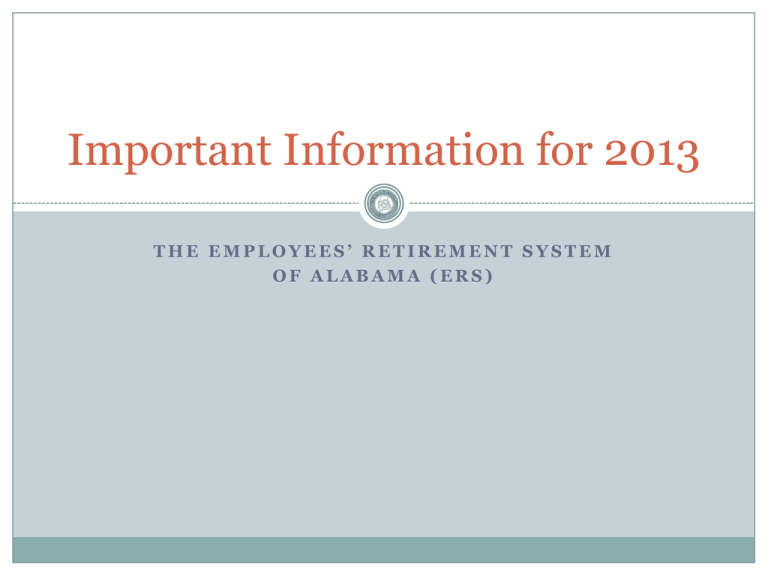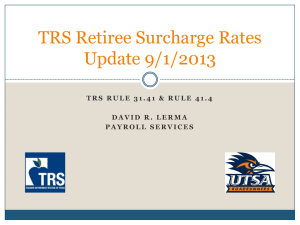PPTX
advertisement

Important Information for 2013 THE EMPLOYEES’ RETIREMENT SYSTEM OF ALABAMA (ERS) Using the CRA Application The CRA application allows an employer to verify if an employee should be placed under Tier I or Tier II for retirement purposes. It is very important that employees hired on or after January 1, 2013, are entered in the payroll system with the correct retirement tier. To determine if a new employee is Tier I or Tier II status, you must visit the RSA website at https://cra.rsa-al.gov for verification. User Name: CRA-Upload Password: R$@upL0@d (that is the number “0”) Enter the nine digit SSN for your employee. Based on current RSA records, the employee’s name and Tier status will be provided. You will be able to print the page for your records. If you believe the RSA records are incorrect, please contact the RSA to discuss the Tier status before initiating the first payroll deduction for the member 2 Using the CRA Application The only way to accurately verify the Tier status is by accessing the RSA website. DO NOT use the ESMT history to verify Tier status for an employee. Employees may have previous creditable retirement service through other plans outside of state government that will not be reflected on the ESMT screen. An employee may have a prior ESMT record but was employed in a classification in which they did not contribute to the RSA so they may not have any actual retirement service credit. Members entered with incorrect Tier or retirement codes will over/under contribute to retirement and require further corrective action by your agency. 3 Using the CRA Application CRA Login Page Enter the User Name and Password 4 Using the CRA Application To verify if an employee should be placed under Tier I or Tier II, you will need to select the “Check Employee Tier Status” button at the bottom of the screen. 5 Using the CRA Application Example #1 Enter the SSN for the employee you wish to verify on the screen below. 6 Using the CRA Application Example #1 The SSN was not found in the system. This employee should be placed under Tier II. 7 Using the CRA Application Example #2 Enter the SSN for the employee you wish to verify on the screen below. 8 Using the CRA Application Example #2 The SSN was found in the system. This employee should be placed under Tier I. Always print a copy of the Tier Status Report and maintain a copy in the personnel file of the employee. 9 Tier I and Tier II Comparison Tier I Date of Employment Prior to January 1, 2013 Member Contribution Rate • • • Retirement Eligibility • • Retirement Factor • • Disability Retirement Tier II On or after January 1, 2013 5% or 7.5% for Regular Employees 6% or 8.5% for FLC Employees 10.0% for State Police • 25 years of service at any age 10 years of service at age 60 (age 52 for State Police) • • No 25-year retirement 10 years of service at age 62 (age 56 for FLC employees and State Police) 2.0125% for Regular Employees 2.875% for State Police • 1.650% for Regular Employees 2.375% for State Police No Change • • • 6.0% for Regular Employees 7.0% for FLC Employees 10.0% for State Police New disability standard 10 Tier I and Tier II Comparison Tier I Tier II Average Final Salary Average of the highest three years of the last ten years Average of the highest five years of the last ten years Benefit Cap None 80% of Average Final Salary Retirement Contributions on Overtime Pay Earnable Compensation cannot exceed 120% of base pay Earnable Compensation cannot exceed 125% of base pay Sick Leave Conversion Yes No FLC Bonus Year/State Police Bonus Yes No 11 Postretirement Employment RSA has a statutory duty to suspend the pension payments of retirees who return to work for an ERS participating employer in violation of the “return to work” provisions of the ERS law. The law allows a retiree to work for a participating employer without suspension of his benefits if (1) the retiree is not employed in a permanent fulltime capacity and (2) in 2013, earns $23,000 or less per calendar year. 12 Postretirement Employment All participating employers have a continuing duty to provide information to the RSA to enforce the pension suspension rules. You must provide the following information as soon as possible but no more than 30 days after the retiree is engaged to perform work for your agency. 1. The names of all RSA retirees who perform services for your entity even if that retiree has been hired through a personal services contract, a contract with a third party or as an independent contractor. (If there are none, you must let us know no later than September 30, 2013.) 2. The annual amount of compensation paid to the retiree. 3. A statement of whether the retiree works full-time, part-time and/or in a permanent position. 4. Copies of any contract or employment agreement related to the retiree’s services. 5. A description of the manner in which the retiree is paid. 6. A description of the duties performed by the retiree, including how the retiree gets assignments. 7. A description of where and when the retiree performs his/her duties, including whether the retiree uses his/her own equipment or that of the participating employer. 8. Any other information which is relevant under the IRS “twenty factor” test, a copy of which is included in this packet. 13 Postretirement Employment A retiree of the Employees’ Retirement System (ERS) or Teachers’ Retirement System (TRS) who is restored to active service with an ERS or TRS member agency may continue to receive full retirement benefits provided that the retired member meets both the following conditions: 1. Retiree must not be employed in a permanent full-time capacity. 2. The retiree’s compensation during the 2013 calendar year cannot exceed $23,000.00. The earnings limit in calendar year 2013 and each calendar year thereafter shall be increased by the same percentage increase as the increase in the Consumer Price Index. If a retiree’s compensation from an ERS or TRS member agency exceeds the above limit, the retirement benefit will be suspended for the remainder of the calendar year. During the year in which retirement is effective, retirees are subject to a prorated earnings limit based upon the number of months remaining in the year. 14 Postretirement Employment An ERS retiree who is employed with a TRS member agency in a permanent full-time position eligible for retirement coverage must begin participation in the TRS. The member’s ERS retirement account will be terminated and the remaining funds and creditable service will be transferred and credited to the account established in the TRS. An ERS or TRS retiree may serve for compensation in an elected public office with the state, a county, or an incorporated municipality and shall be eligible to continue to receive his or her retirement benefit provided that the public office is not covered by the ERS or TRS. If the office, whether full-time or part-time, is covered by the ERS or TRS, the retiree shall be subject to the earnings limit. 15 Postretirement Employment The compensation of retirees who provide services to participating agencies on a contractual basis may be subject to the above-stated limitations. If a retiree has entered into or is considering entering into a contract with a participating agency of the ERS or TRS, it is recommended that the retiree provide a copy of the contract or proposed contract to the ERS or TRS for a determination as to whether or not such contract would affect the retiree’s benefit. Employment with private industry, private education, or a nonparticipating agency will not affect a service retiree’s benefit from the ERS. 16 Postretirement Employment In addition to the earnings limitations stated above, a disability retiree’s earnings are also limited to the difference between his/her average final compensation and annual retirement benefit regardless of whether or not the employer is an ERS or TRS member agency. The average final compensation is the salary used in the computation of the disability retirement benefit. The State Ethics commission recommends that a retired public official or public employee who desires to come back to work on a part-time basis contact the Ethics Commission for a determination as to whether or not doing so would be prohibited under the Revolving Door provisions of the Ethics Law. The ERS should be notified immediately when a retiree’s employment status or compensation does not comply with the above limitations. 17 Postretirement Employment The following formula is used to calculate the prorated earning limit for retired employees who return to work in the same calendar year in which they retired. Step 1: Take the number of months left in the calendar year and divide by 12 (months) Step 2: Multiply $23,000 (yearly earnings limit for 2013) by the percentage from Step 1. Step 3: The amount from Step 2 is the total earnings limit for the current calendar year. 18 Postretirement Employment Example: 7 months left divided by 12 months = 58% $23,000 x 58% = $13,340 (maximum earnings limit for the remainder of the calendar year) 19





